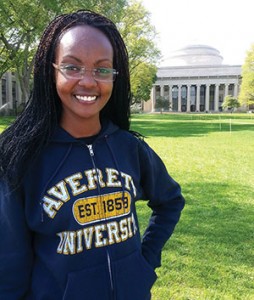Averett alumna Esther Nyokabi Njuguna ’12 grew up just outside Nairobi, Kenya. When you hear that, do you picture young Esther walking over hard-packed red dirt, her little feet kicking up puffs of dust as grown women from her tribe walk alongside her, balancing huge baskets of laundry or food on their heads?
That’s a familiar image to us over here, accustomed as we are to the Africa of Ernest Hemingway, Humphrey Bogart and Isaac Dinesen. But it’s rare, these days.
 In fact, Esther lived in a modern house in Nairobi’s suburbs, and Nairobi itself is bustling. It’s a huge capital city, weighing in at almost three million residents. Walk through its center and you are swimming in the exotic food smells, colors, sounds and throngs of people that only a cosmopolitan, international city can offer.
In fact, Esther lived in a modern house in Nairobi’s suburbs, and Nairobi itself is bustling. It’s a huge capital city, weighing in at almost three million residents. Walk through its center and you are swimming in the exotic food smells, colors, sounds and throngs of people that only a cosmopolitan, international city can offer.
Esther does speak Kikuyu as her native tongue, and it is the language of her ethnic group (not “tribe”). But she also speaks German. And English. And Swahili. Her schooling began at the age of four, and that’s when her formal study of languages commenced. This is a multilingual — and now multicultural — woman … who had never traveled outside Kenya before she went to Averett University.
In fact, her Kenyan background gave her some very interesting challenges, including anxiety over getting hearty breakfasts at the AU Student Center. Here’s what happened: Esther grew up knowing with certainty that she would awaken at first light. She also knew that at sunset, it was time to go home, go inside for the evening meal. She was able to use the sun as a consistent clock because Kenya is directly on the equator. So in Nairobi, sunrise and sunset are always at the same time. Always.
Not in Danville, VA, USA.
So on her first morning as an Averett student, Esther was up and charging on full energy. She literally ran to the cafeteria for her first student meal, only to find the building locked. She had gotten up at 5; it opened at 7. And in her excitement over the trip to America, she had failed to pack a watch.
Averett University Executive Vice President Charles Harris is an early riser, too, normally hitting the campus by 6 a.m. He saw Esther standing all alone at the cafeteria door, waiting. “You must be very hungry,” he said to her. “Yes, I am,” she said. He gave her a newspaper to read while she waited. Today she admits that he confused her — why must she be very hungry to go for a student meal? Why would she want a newspaper while she’s standing at the door?
Eventually she got in and ate, but with the next day came the same routine — locked door, almost two hours to wait, Mr. Harris being nice. Another newspaper.
Finally, she says, she figured it out. Also, she got a watch.
“The best of it,” she adds, “is that Mr. Harris and I connected, and during my years at Averett, he met with me every Friday to talk about my goals, my plans, my challenges … everything, really.”
She feels that Harris became a mentor, a friend, even a substitute father. Esther proclaims that even if she had gained nothing at Averett other than her relationship with Mr. Harris, “that would have been enough.”
But oh, she gained so much more.
Here’s how it began. Young Esther decided that she wanted to be an astronaut. Her brother, wise as only an elder sibling can be, told her she needed to learn to fly first … that flying is the way to end up in space. It made sense to her, and she began to dream of becoming a pilot.
“I always thought that flying would be the most exhilarating thing for me,” she says. “Just the thought of it — that tons of people would be in my planes, with their lives in my hand. That is exciting.”
She decided to go to an aviation school, even though she had never left Kenya before, nor had she ever been in an airplane. She had no connections to the world of aviation. She didn’t even know if she was afraid of heights.
Her father always maintained that the United States had the best institutions of higher education. So when Esther began her meticulous search for the right aviation school, she decided that America was the right place.
She knew that the aviation industry was well established in the U.S., and she felt that she really wanted the North American experience of flight.
She applied to a Kenyan organization that helps students apply to colleges in the U.S. Her goals, she said, were compound: She wanted to fly, yes, but
also she really wanted to earn a four-year degree. “I figured that if I was going to travel all that way, that far from home for so many years, I should also get a degree.”
The lady in charge looked up flying and four-year degrees in the U.S., starting (of course) in alphabetical order … AVERETT!
Fortunately, Esther then went to the Averett website and liked what she saw (including, she confesses with a bright smile, our colors. Yes!).
There were other factors, of course. All of Esther’s friends who had preceded her to America had gone to large universities, and they all warned her that they had become very small fish in a very big ocean.
“I knew that I was used to a tiny school,” she says, “and I knew I would be just a number, I would get lost, in a big American college. My gosh, when I applied to Averett, its enrollment number seemed really large to me! Then I got there and right away they knew my name, where I was from … oh, it made a huge difference; it was such a good thing.”
The very bright and bright-eyed Esther proceeded to her aviation classes, but she was terrified. She felt overwhelmed almost immediately, and she told her aviation instructor that she needed a tutor. Not surprisingly, by the end of the first semester, Esther herself was tutoring others. That sequence — being extremely nervous upon starting at Averett and then quickly gaining confidence — was to be reversed at MIT.
“When I walked onto the MIT campus to begin graduate school,” Esther laughingly admits, “I thought, ‘I OWN this place!’ But it turned out to be the most humbling, challenging — just downright HARD — thing I’ve ever gotten myself into.”
There’s no way to sugarcoat it: MIT is hard. Esther says that over her semesters there, she has been challenged, tested, tried and re-tested to an extent she never imagined.
She only applied to three graduate programs: MIT, Columbia and Boston University. She was swinging big, aiming for the big leagues. And all three graduate schools said Yes.
It stands to reason that she would be accepted anywhere she looked. She’s an articulate, charming, gracious and obviously intelligent scholar who is certainly not afraid to explore and to work hard.
During her time at MIT, she worked one whole summer as a research intern in the Department of Civil Engineering at Technion — Israel Institute of Technology. That means she went far away, again, this time to live and work in Haifa, Israel, at a public research university. She spent the summer designing and implementing a survey tool to help the airline industry understand customers’decision-making processes.
That was not her first internship. While at Averett, she spent an entire month living and working in the U.S. Travel Association’s Office of Government Relations in Washington, DC, while also taking classes at Georgetown University.
The DC internship was a real eye-opener. She got to spend time with various policymakers on Capitol Hill, and she conducted research on national issues concerning the TSA and visa reforms in India and Brazil. But what really shocked her, she says, was the quality of the other interns.
“They were from all over the country, they were extremely sharp, and [here’s what got to her] I realized that we would all be competing for the same slots in graduate schools. I knew right then that I had to step up my game.”
It’s doubtful that Esther needed further motivation, but she got it that summer. She also was able to pursue aspects of her expanded focus. Instead of being a pilot, Esther now had her sights trained on all the ancillary areas of aviation — airlines, airports, transportation, and so on.
She does still plan to fly, but not for a living. She is exploring all areas of the aerospace industries … and her Master’s from MIT in Transportation — in the Department of Civil and Environmental Engineering — certainly will facilitate that.
Esther is quick to point out that if she had gone straight to MIT from Kenya, she would have failed. Most definitely, she feels. “Averett prepared me,” she says. “It took me in and nurtured me. The environment there is so welcoming, so supportive, and that is exactly what I needed. Averett made MIT possible for me.”
At this point in her journey, she has complete confidence that she will earn the Master’s degree in Transportation from MIT. What will be next?
A strong, lifelong Christian, Esther is determined to stay in this country long enough to gain significant practical experience and to repay what she feels is a debt of gratitude. She is grateful for the education she has received here, and she wants to work here long enough to reciprocate, to help others.
Then it will be back to Africa. She might contribute her talents to an aviation startup in Kenya, or to an established airline … she might even accept a government posting in the transportation industry.
“So right now,” someone fond of puns suggests, “your future plans are up in the air.” She laughs, always gracious.



